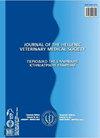α硫辛酸对实验性肾结石发病机制及上皮间质转化的影响
IF 0.4
4区 农林科学
Q4 VETERINARY SCIENCES
引用次数: 0
摘要
本研究研究了草酸钙(CaOx)晶体形成对大鼠肾脏的影响以及α -硫辛酸(ALA)对这一过程的影响。实验分为6组,每组10只大鼠。各组小鼠饮水中分别添加乙二醇(EG)和氯化铵(AC) (0.75% EG + 0.75% AC) 7、14 d诱导肾结石。通过组织病理学、免疫组织化学和生化方法研究CaOx对肾脏和ALA (100 mg/kg/d /口服)对这一过程的影响。在组织病理学检查中,EG+AC应用7天和14天均引起小管腔内晶体积聚,小管囊性扩张,小管上皮积水变性。然而,仅在14天内观察到炎症细胞浸润。免疫组化检查中,EG+AC仅给药14 d,可引起小管间质区ED1、α-平滑肌肌动蛋白(α-SMA)、vimentin的表达。而在小管上皮细胞中未见α-SMA和vimentin的表达。14 d时,在小管上皮和小管间细胞中也检测到转化生长因子β -1 (TGF-β1)的表达。结果表明,ALA加EG+AC可减少小管腔内晶体积累(p<0.001)、小管上皮变性(p<0.001)和TGF-β1的表达。此外,检测到ALA引起谷胱甘肽过氧化物酶(GPx) (p> 0.001)和过氧化氢酶(CAT) (p>0.05)活性升高,随EG+AC的施用而降低。本文章由计算机程序翻译,如有差异,请以英文原文为准。
The Effect of Alpha Lipoic Acid on Pathogenesis of Experimental Nephrolithiasis and Epithelial Mesenchymal Transition
In this study, the effects of calcium oxalate (CaOx) crystal formation on the kidneys and the effect of alpha-lipoic acid (ALA) on this process were investigated in rats. The study consists of 6 groups with 10 rats in each group. Ethylene glycol (EG) and ammonium chloride (AC) (0.75% EG + 0.75% AC) were added to the drinking water of different groups for 7 or 14 days to induce nephrolithiasis. The effects of the CaOx on the kidneys and ALA (100 mg/kg/day/orally) on this process were investigated via histopathological, immunohistochemical, and biochemical methods. In the histopathological examination, EG+AC application for both 7 and 14 days caused crystal accumulation in the tubule lumens, cystically dilated tubules, and hydropic degeneration in the tubular epithelium. However, inflammatory cell infiltration was observed merely in 14 days. In the immunohistochemical examination, when EG+AC administration was applied for 14 days only, it caused expression of ED1, alpha smooth muscle actin (α-SMA), and vimentin in the tubulointerstitial areas. However, α-SMA and vimentin expression was not observed in tubular epithelial cells. Transforming growth factor beta-1 (TGF-β1) expression was also detected in the tubular epithelium and intertubular cells at 14 days. It was determined that ALA administration with EG+AC application reduced the crystal accumulation in the tubule lumens (p<0.001), the degeneration of the tubular epithelium (p<0.001), and the expression of TGF-β1. In addition, it was detected that ALA caused an increase in glutathione peroxidase (GPx) (p<0.001) and Catalase (CAT) (p>0.05) activities, which decreased with EG+AC application.
求助全文
通过发布文献求助,成功后即可免费获取论文全文。
去求助
来源期刊

Journal of the Hellenic Veterinary Medical Society
VETERINARY SCIENCES-
CiteScore
0.60
自引率
0.00%
发文量
83
审稿时长
>12 weeks
期刊介绍:
The Journal of the Hellenic Veterinary Medical Society (J Hellenic Vet Med Soc) is a quarterly peer-reviewed journal that publishes articles in all aspects of veterinary science and related disciplines. It is published by the Hellenic Veterinary Medical Society and is indexed in the Web of Science and in Scopus.
There are no publication fees in the journal. Authors considering submitting manuscripts for evaluation and publication are requested to read carefully the instructions for authors and fully comply with them.
Non-complying manuscripts may be returned to the corresponding author for formatting.
 求助内容:
求助内容: 应助结果提醒方式:
应助结果提醒方式:


